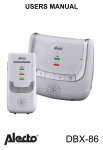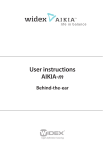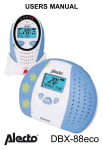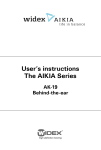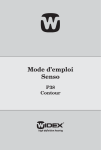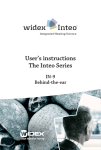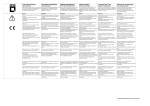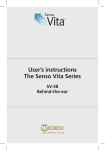Download Widex Senso System P38 Troubleshooting guide
Transcript
User’s instructions The Senso System P38 Behind-the-ear Your hearing aid, é-tip and accessories may not look exactly the same as in these user’s instructions. We furthermore reserve the right to make any changes considered necessary. Hearing aids and their accessories should not be disposed of with normal household waste. Please consult your national Widex distributor for advice on how to dispose of your hearing aid. 2 Contents Turning the hearing aid on and off . . . . . . . . . . . 5 Automatic adjustment of loudness . . . . . . . . . . . 6 Fine tuning loudness . . . . . . . . . . . . . . . . . . . . . . 7 Telecoil (M-MT-T switch). . . . . . . . . . . . . . . . . . . 8 Changing the battery . . . . . . . . . . . . . . . . . . . . . 10 Recommended energy source: Zinc Air battery type 675 . . . . . . . . . . . . . . . . . . 12 Left/right identification . . . . . . . . . . . . . . . . . . . 13 Placing Senso on/in the ear . . . . . . . . . . . . . . . . 14 Removing Senso . . . . . . . . . . . . . . . . . . . . . . . . . 16 In case of malfunction . . . . . . . . . . . . . . . . . . . . 17 Audio input . . . . . . . . . . . . . . . . . . . . . . . . . . . . . 20 Caring for your hearing aid . . . . . . . . . . . . . . . . 23 Accessories. . . . . . . . . . . . . . . . . . . . . . . . . . . 25 The hearing aid . . . . . . . . . . . . . . . . . . . . . . . 26 The earmould . . . . . . . . . . . . . . . . . . . . . . . . 27 There is only one way . . . . . . . . . . . . . . . . . . . . 29 Troubleshooting guide . . . . . . . . . . . . . . . . . . . . 30 3 Your Widex Senso hearing aid is a very intricate, high precision electronic unit. It has been carefully designed to withstand years of wear, under the varying conditions the typical user finds themselves in each day. However, your hearing aid may be damaged if exposed to extreme conditions, severe blows, or general neglect. To get full satisfaction from the quality and the performance we have built into your new Widex hearing aid, please handle it with care, and read and follow the instructions carefully. At the back of this manual you will find a troubleshooting guide, which will help you in situations where your hearing aid does not perform according to your expectations. We hope you will be pleased with your new Widex hearing aid! A. Volume control B. Telecoil (M-MT-T switch) C. On/off switch and battery drawer 4 Turning the hearing aid on and off The battery drawer also functions as the on/off switch. The hearing aid is turned on when the switch is pushed upwards, and off when the switch is pushed downwards as illustrated. The word “OFF” is clearly visible on the switch when the aid is turned off. Please remember to switch the hearing aid off when it is not in use. Remove the battery if the hearing aid will not be used again soon. 5 Automatic adjustment of loudness Senso P38 is equipped with a computer which has been designed to adjust its loudness automatically in accordance with the sound environment around you. Several thousand times per second, Senso analyses the surroundings and tailors its sound accordingly. With Senso you do not have to think about adjusting the volume – it happens quite automatically. 6 Fine tuning loudness If you have a Senso P38 with a digital volume control, you can fine tune the volume to make it more comfortable when needed. Press the lever upwards to slightly raise the volume of the automatic setting. Press the lever downwards to slightly lower the volume of the automatic setting. When you raise the volume, you will hear a beep-tone for each step the volume is raised. When the maximum adjustment level is reached, a steady tone will sound until you release the lever. When you lower the volume, you will hear a deeper beep-tone for each step the volume is lowered. When the minimum adjustment level is reached, a steady tone will sound until you release the lever. Note: Senso P38 is a powerful hearing aid. Avoid prolonged use at uncomfortably high sound pressure levels – it might damage your hearing. For further information, consult your hearing healthcare professional. 7 Telecoil (M-MT-T switch) “M” (microphone): For normal use, the switch should be in position “M” (microphone). “T” (telecoil): Position “T” cuts off the microphone and brings the built-in telecoil into operation. The hearing aid can then be used within any magnetic field or loop system without background interference. A loop system or magnetic field device can be fitted to a TV or radio. Some public places such as churches, theatres, cinemas and lecture rooms are already equipped with a loop system. Ask your hearing healthcare professional for more information. 8 Note: The magnetic field in some telephones is inadequate, in which case the “M” position should be used. “MT” (microphone + telecoil): If you want to listen both via the microphone and the telecoil, place the switch in mid-position “MT” (e.g. when watching TV while still wanting to hear the doorbell, telephone, or other persons speaking). 9 Changing the battery Before inserting a new battery in your hearing aid, remember to remove the adhesive tab. Do not use batteries on which there is a sticky residue from the tab or other unwanted substance as this can block the battery airholes. Push the nail grip downwards to swing open the battery drawer. The nail grip is located on the opposite side of the on/off switch at the bottom of the hearing aid. The battery must be placed with the plus (+) sign visible, in accordance with the plus (+) sign on the battery drawer. If the battery drawer does not close easily, the battery is incorrectly inserted. When changing batteries, make sure to hold the hearing aid over a table or a carpet to make it easier to find a dropped hearing aid or battery. 10 Exhausted batteries: If you hear four rapid beeptones while wearing your hearing aid, it is an indication that you should exchange the battery as soon as possible as the battery is nearly exhausted. Once the battery is totally exhausted, the hearing aid will be completely silent. Exactly how long the hearing aid will function after the beep-tones varies from one case to another. We recommend that you always have a spare battery with you. Never leave an exhausted battery in the hearing aid. Exhausted batteries may leak, which could damage your hearing aid. 11 Recommended energy source: Zinc Air battery type 675 This hearing aid uses an environmentally friendly, type 675 Zinc Air battery, which provides a long lifetime when treated correctly. Please note the expiry date code on the battery pack stating how long the batteries will be good. Do not remove the adhesive tab until just before inserting the battery in the hearing aid. Once inserted, the battery will start functioning after a few seconds. Operate your hearing aid with the same battery until it is exhausted. The lifetime of the battery depends on a number of factors, such as the setting of your hearing aid, how many hours you use it daily and the listening environments in which you use it. On occasion, a new battery may be exhausted because it was not sealed properly. If your hearing aid does not work after you have replaced the battery, try inserting a different new battery. 12 Left/right identification If you are wearing hearing aids on both ears, and you want to make sure you are placing them correctly, you can arrange with your hearing healthcare professional to have a small identification mark (red nameplate) on the right-ear hearing aid. 13 Placing Senso on/in the ear Insert a battery in your hearing aid. We recommend that you turn off the hearing aid before placing it on the ear. First insert the earmould in the ear canal while holding the lower part of the tubing. It may also be helpful to gently pull the outer ear backwards and upwards with the opposite hand. 14 Once the earmould has been inserted, you place the hearing aid behind the ear, so that the hook rests comfortably on the ear, close to your head. When the hearing aid is in its correct position, turn on the hearing aid. 15 Removing Senso First remove the hearing aid from its position behind the ear. Carefully pull the earmould out of the ear canal, while holding the lower part of the tubing. If it is difficult, it may help to try to move the earmould carefully from side to side while pulling it out. It may also help to pull the outer ear upwards and backwards with the opposite hand. 16 In case of malfunction Should your hearing aid be completely or periodically dead, try the following before consulting your hearing healthcare professional: • Make sure the hearing aid is switched on. • Disconnect the tubing with earmould from the hook of the hearing aid and check if there is moisture in the tubing. • Check that the earmould is not blocked by earwax. Disconnect the tubing with earmould from the hook of the hearing aid and try to blow air through the earmould with a small blower. • Change the battery and make sure the new battery is correctly inserted. See the Troubleshooting guide p. 30-31. 17 Important Please be sure to keep your hearing aid and its accessories out of the reach of children, who might place them in their mouths. Also keep batteries out of children’s reach and discard used batteries carefully. Do not change batteries in front of children or let them see where you keep your supply. Never put batteries in your mouth for any reason and never let a child obtain a battery or place it in his or her mouth. In case of ingestion, contact your physician immediately. The hearing aid is made of modern non-allergenic materials. Still, in rare cases skin irritation can occur. If you notice skin irritation in or around your ear or ear canal, contact your hearing healthcare professional. The use of hearing aids increases the risk of accumulation of earwax, which can temporarily reduce your hearing ability. Contact your ENT doctor if you suspect that a plug of earwax has accumulated in your ear. 18 Please be aware that the use of any type of earmould may involve a slightly increased risk of infection in the ear canal. An infection can arise as a result of inadequate ventilation of the ear or scratches in the ear canal caused by the earmould. Therefore, we recommend that you take off your earmould at night to allow the ear canal to be ventilated. Make sure that you clean and inspect your earmould as required. If an infection occurs it is a good idea to clean your earmould with a disinfecting tissue or the like. Do not under any circumstances use alcohol, chlorine or similar substances to clean your earmould. When not in use When your hearing aid is not in use, it should be placed in the small case, which you can easily carry in a pocket or purse. Never expose the hearing aid to excessive heat, such as leaving it on a window sill, near a radiator or near a car window. 19 Audio input Senso can be furnished with an audio shoe. This allows direct connection to CROS/BiCROS systems as well as assistive listening devices such as FM equipment, handheld microphones, TVs, and cassette players. Connecting the audio shoe Before connecting, the little cover on the side of the hearing aid must be replaced with the cover which has one hole. A Europlug is used for connection. Insert the plug into the socket on the base of the audio shoe. Please note that the plug will only connect one way, as one of the three pins is thicker than the other two. Make sure that the M-MT-T switch is set to M (microphone). 20 Slide the audio shoe onto the hearing aid, as shown. Press the shoe gently onto the aid until you feel a click. If the audio shoe is equipped with a switch, you have the choice of listening to audio input only (MIC OFF) or to audio input plus hearing aid microphone (MIC ON). Remove the audio shoe by gently sliding it off and pulling it away from the hearing aid, as shown. 21 CROS/BiCROS with an audio shoe and a CROS dummy The audio shoe can also be used together with CROS/ BiCROS. For this, a CROS dummy and a cord with a Europlug at both ends are used. Important: If the hearing aid is connected to equipment which is connected to the electrical mains, this equipment must meet the safety requirements stated in the international standard IEC 65. Do not connect the hearing aid to sockets that are labelled with one or more of the following symbols: 22 Caring for your hearing aid With proper care, your hearing aid will give you years of reliable service. Here are some things you can do to prolong the life of your aid: Treat your hearing aid as the valuable object it is: with care! When not in use, keep it in its case in a cool, dry location where it cannot be reached by children or pets. Never expose it to extreme temperatures or high humidity. Do not wear your aid in the shower or swimming, or when using a hair dryer, hair spray, or other sprays. 23 Do not wear your hearing aid during x-ray, MR scans, CT scans, short-wave diathermy, or similar radiation treatments. Some types of radiation can damage your hearing aid. Other types of radiation from, for example, burglar alarms, room surveillance equipment, and cellular telephones, are weaker and will not damage your hearing aid. Widex hearing aids are not certified for use in mines or other areas with explosive gases. Switch your hearing aid off when it is not in use. Should you not use it for a day or more, take out the battery to avoid battery leakage. Always insert the battery as described on page 10. If you feel the battery needs to be forced into the battery drawer, then check to see if it’s upside down. Never try to open or repair the hearing aid yourself 24 Accessories The following accessories are available for your hearing aid: A. Battery magnet to facilitate insertion of the battery into the battery drawer. B. Wax removing tool for cleaning the relief vent opening. C. Soft cloth for drying and cleaning the hearing aid. 25 The hearing aid Never wash your hearing aid with water, cleaning solutions or other liquids. Instead, clean your hearing aid with a dry soft cloth after use. When the hearing aid is not in use, it is a good idea to leave the battery drawer open, so as to ventilate the aid and allow it to dry. 26 The earmould Make sure your earmould is clean and free of earwax and moisture. If it is plugged, clear the opening with the wax removing tool. If this is not sufficient, disconnect the plastic tube from the hook of the hearing aid and wash the earmould in lukewarm water and a mild dishwashing soap. Rinse in cold water. Allow the earmould to dry overnight. 27 If there is still moisture in the earmould or tube, use a syringe or a small blower to blow it dry. Do not use alcohol to clean your earmould! If your earmould tubing becomes stiff, yellow or cracked, contact your hearing healthcare professional for a replacement. 28 There is only one way Your hearing aid does not restore normal hearing, but it will help you to hear and understand what other people are saying – and to enjoy many other sounds. So don’t give up. The learning process will take time, but millions of experienced users can testify that the results are worth the effort. There are no tricks or short cuts by which you can obtain immediate and full benefit from your hearing aid. Only consistent and determined practice will give you the maximum results from your hearing aid. It takes time getting used to “hearing” again and to having “something” in your ear. Your ear may even become a little sore at first, but that will pass. The sooner you become accustomed to wearing the hearing aid every day and all day long, the sooner you will succeed. Take the time and effort. Hearing more out of life is worth it! 29 Troubleshooting guide Symptom Cause Possible remedy Dead Not turned on Turn it on Battery is dead or does not work Replace battery. Insert battery correctly Poor battery contact Clean battery contacts with a cotton bud Blocked earmould Clear earmould blockage Battery low Replace battery Blocked earmould Clear earmould blockage Not loud enough Change in hearing See your hearing healthcare professional Earwax blockage in your ear 30 See your ENT doctor Symptom Cause Possible remedy Feedback whistling Earmould loose Remove and reinsert Earmould too small New earmould required Crack in tubing Replace tubing Crack in hook/ elbow See your hearing healthcare professional Battery contacts dirty Clean battery contacts Intermittent sound On/off switch dirty Push the switch back and forth a couple of times 31 ¡9 514 0016 001a¤ ¡#02y¤ Printed by HTO / 2005-11 9 514 0016 001 #02



































